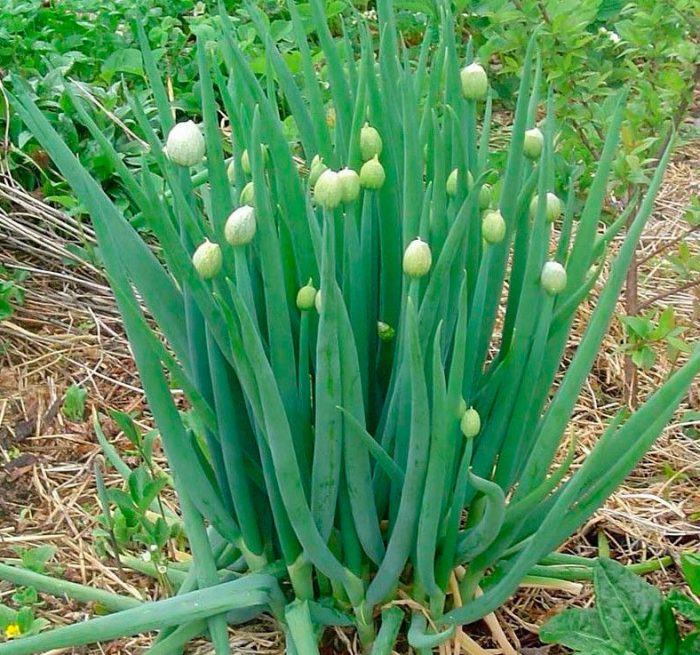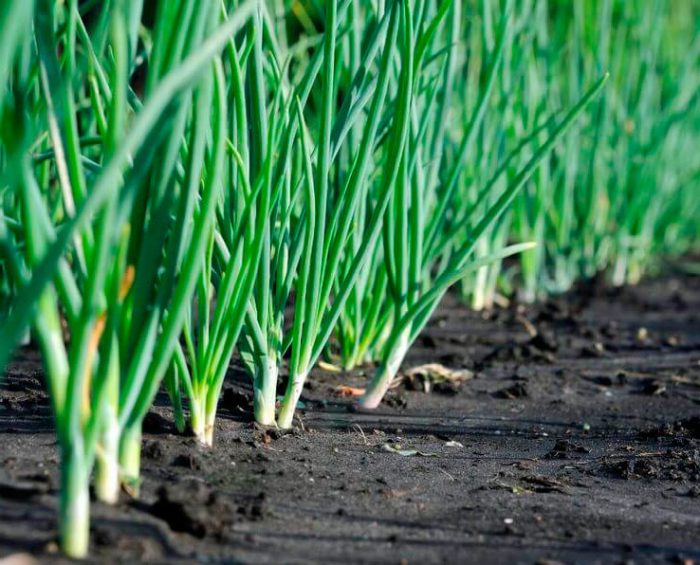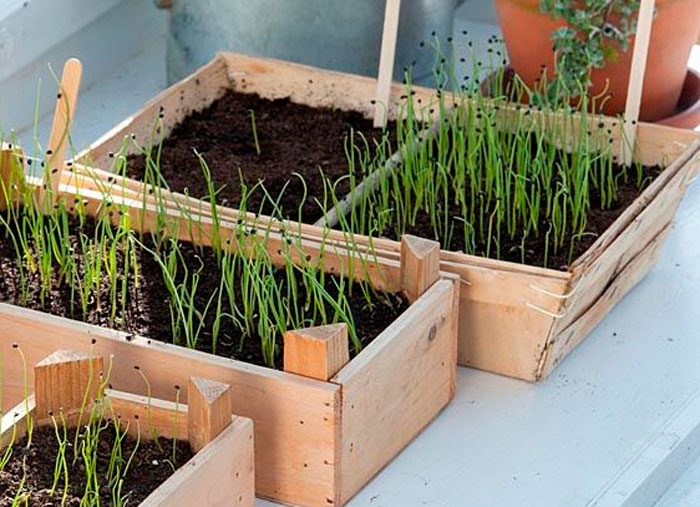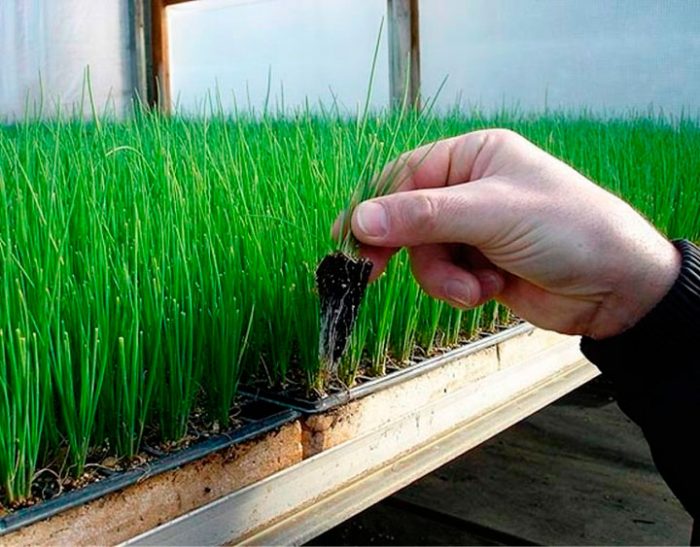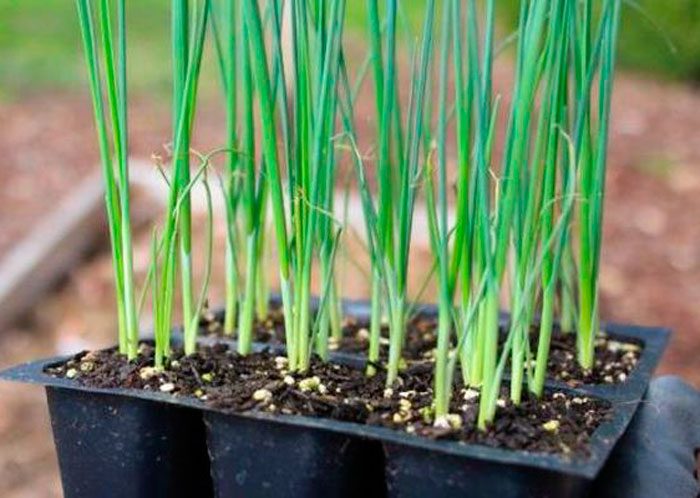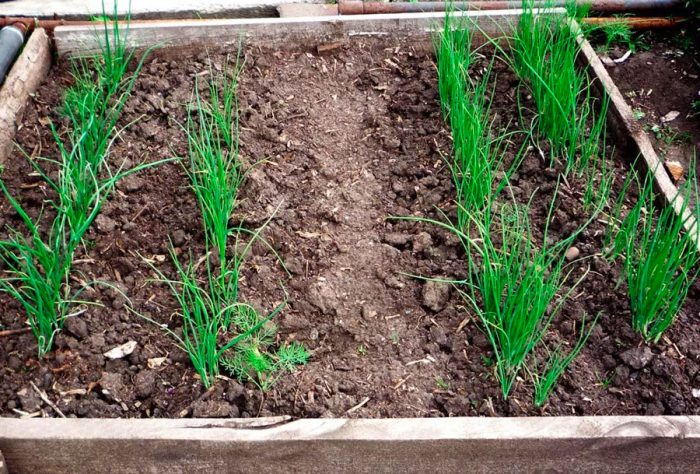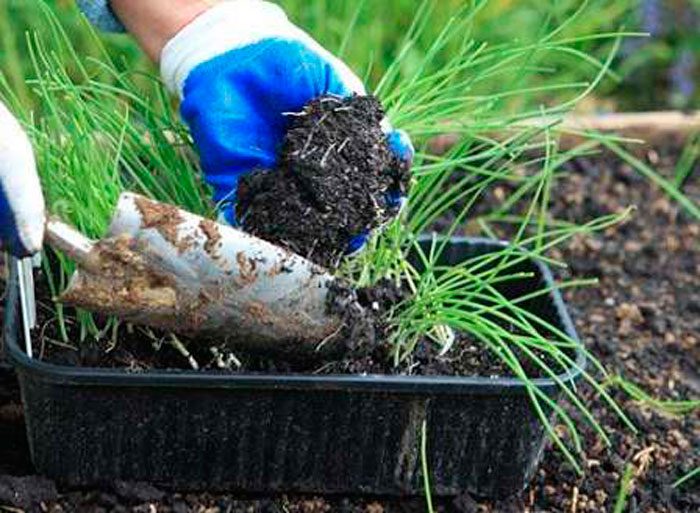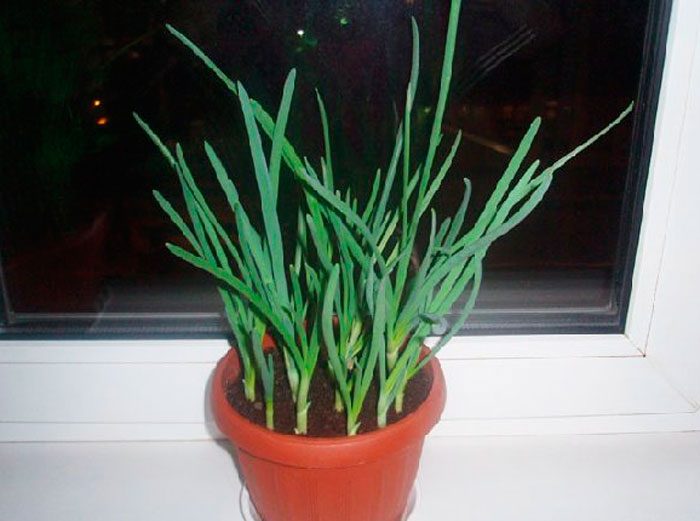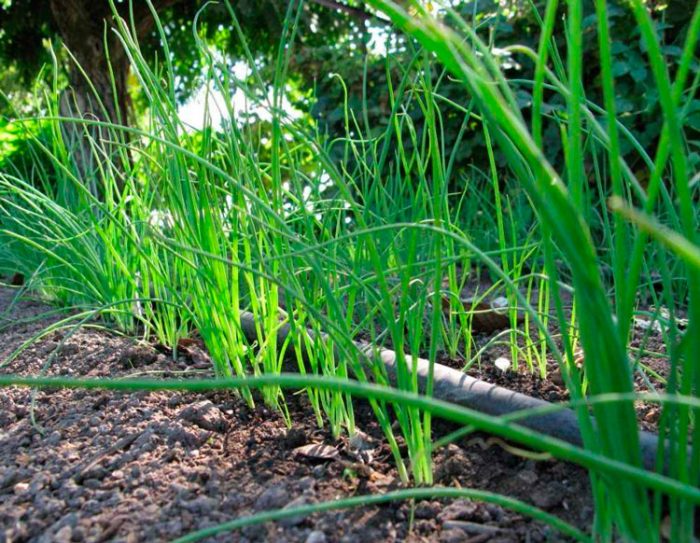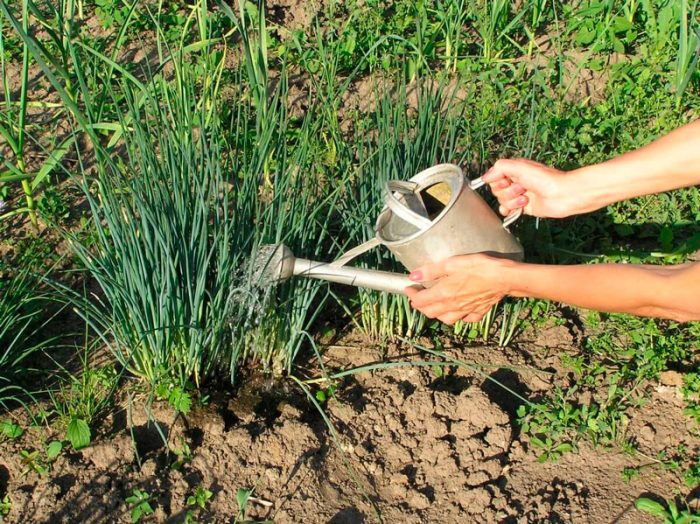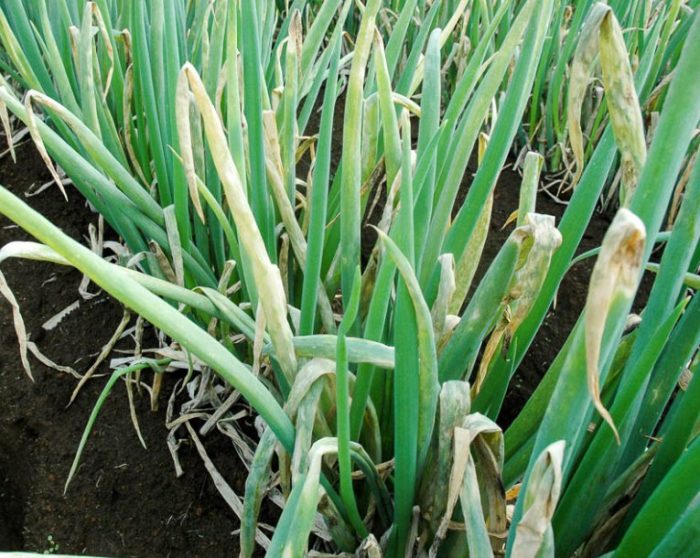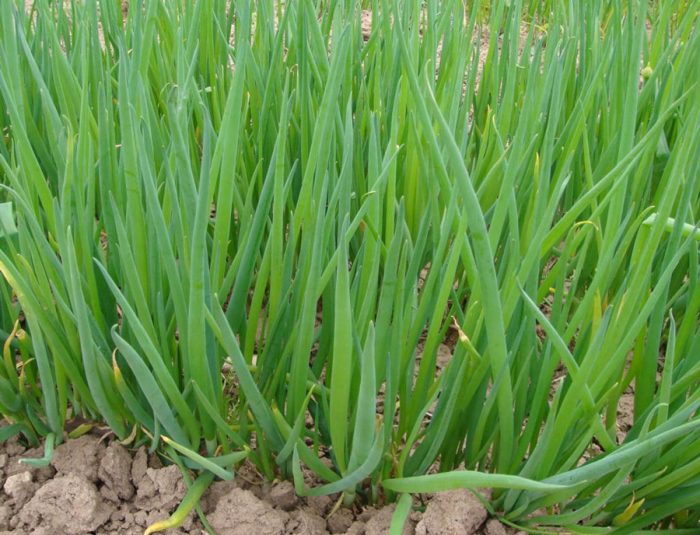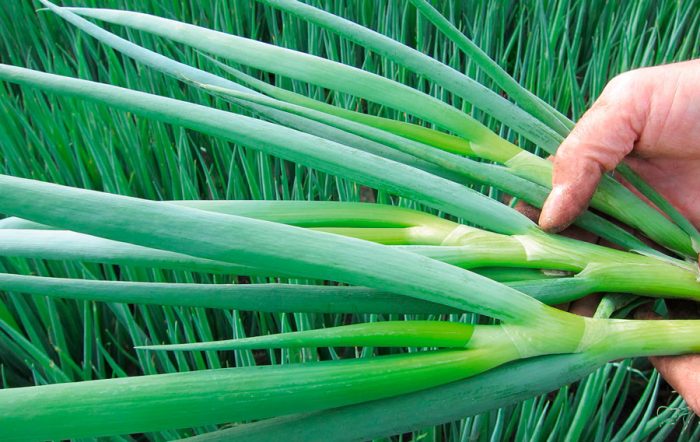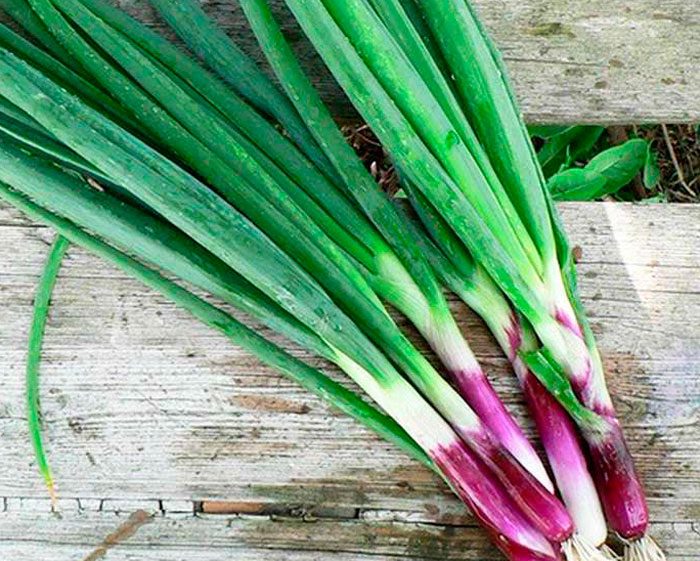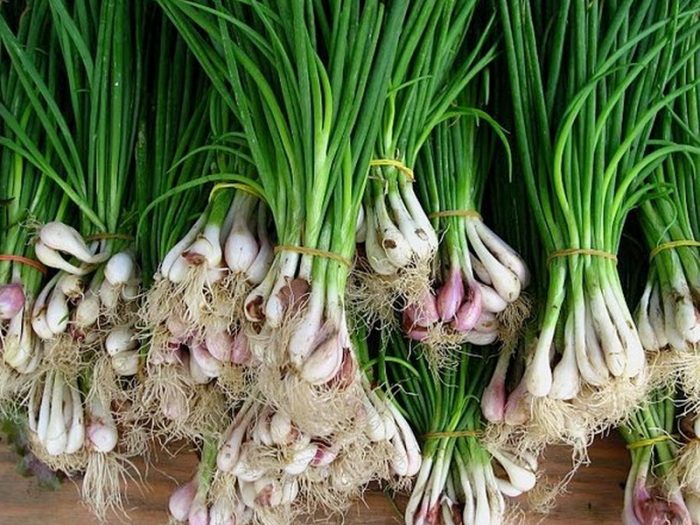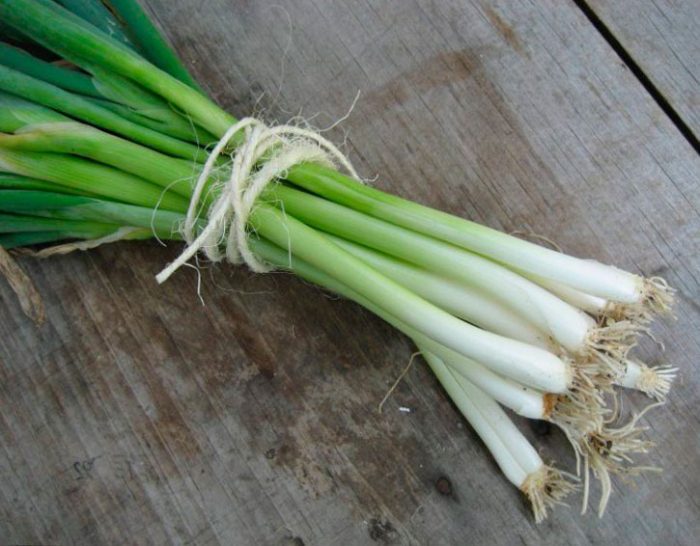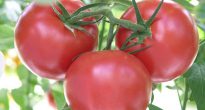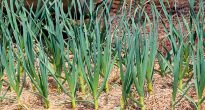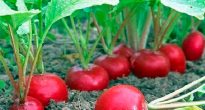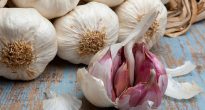The herbaceous perennial plant onion (Allium fistulosum), also called Tatar, or fistus, or sand, or Chinese, is a species of the genus Onion. Many experts believe that the batun comes from Asia, since today it can be found in natural conditions in Japan, China and Siberia. This plant is cultivated in all countries. It is grown to produce green feathers that taste milder than onions. Underdeveloped bulbs have an oblong shape. The stem is thick and hollow inside, its height can reach 100 cm. The fisty foliage is wider than onion. During flowering, umbrella-shaped spherical inflorescences are formed on the bushes, which include many flowers. For reproduction of such a plant, the seed method and division of the bush are used. It is grown through seedlings only when they want to get juicy greens in early spring, but they forgot to sow seeds in late autumn.
Content
Brief description of cultivation
- Sowing... Seedlings are sown on seedlings in mid-April, and seedlings are planted in open soil in mid-June.
- Illumination... Shaded or sunny area.
- Priming... A neutral or slightly acidic moist nutritious loamy or sandy loam soil is well suited.
- Watering... It should be systematic and very abundant. So, after watering, the soil should be soaked to a depth of about 0.2 m. If it rains regularly in the summer, then the bushes can be watered about 2 times every 7 days. However, during a prolonged dry period, watering the site is carried out 1 time in 2 days.
- Fertilizer... For this, organic matter is used, for example: wood ash, slurry or a solution of bird droppings. In this case, feeding with bird droppings is carried out only once, because this onion can accumulate nitrates.
- Reproduction... Seeds.
- Harmful insects... Onion flies, weevils and moths.
- Diseases... Peronosporosis (downy mildew).
- Properties... It has a high nutritional value; the batun is used in dietary nutrition.
Growing onions from seeds
Sowing seedlings
So that in the spring it is definitely possible to get a harvest of onions, it is recommended to grow it through seedlings. In eastern countries, this method of reproduction is very popular, since in this case, in an annual culture, this plant is much less likely to get powdery mildew, in addition, thanks to the seedling method of growing, the ripening processes are accelerated.
Sowing seeds for seedlings is carried out in mid-April, and the plants are transplanted into open soil in mid-June. Harvesting the greens of the batun is carried out in early autumn along with the false bulbs. For growing seedlings, a substrate consisting of sod land and humus (1: 1) is used. In 10 liters of ready-made soil mixture, 70–75 grams of mineral fertilizer for garden plants should be added, and another 0.4–0.5 liters of wood ash. Then everything must be mixed well. Next, the soil mixture is sterilized, for this it is steamed in an oven or heated in a microwave oven, instead, it can be simply spilled with a solution of potassium manganese of a dark pink color.
Before sowing, the seed is placed in water for 24 hours, which must be replaced every 6 hours. Then, for 2-3 days, they are placed on a refrigerator shelf intended for vegetables. The pulled out seed must be dried to a free-flowing state, after which you can start sowing. To do this, the box is filled with prepared soil mixture, in which shallow furrows (from 0.8 to 1 cm) must be made, the width between them should be from 40 to 50 mm. You can also grow seedlings by the bouquet method, for this sowing is carried out in pots reaching 40-50 mm in diameter, with 4 to 6 seeds placed in 1. Crops from above are covered with a thin layer of substrate, and then the surface of the soil mixture is leveled in the container and slightly tamped. After that, its surface must be covered with a layer of calcined clean sand, the thickness of which should be about 0.3 cm. Further, the crops are watered using a spray bottle, this must be done very carefully so as not to wash out a thin layer of sand. Next, the container is covered from above with glass (film) and transferred to a sufficiently warm place (from 18 to 20 degrees).
Growing seedlings
Immediately after the first seedlings appear, the crops are transferred to a well-lit place, where for 7 days they should be at an air temperature of 9 to 12 degrees. After this time, the seedlings are set to the following temperature regime: in the daytime - from 13 to 15 degrees, and at night - from 10 to 12 degrees. In the event that you do not have a place with a suitable temperature, you will have to arrange frequent ventilation, and do not forget to protect the plant from drafts. Since at this time of the year the daylight hours are still very short, it is recommended that the seedlings arrange additional lighting. It should be taken into account that for normal growth and development of bushes, the duration of daylight hours should be about 14 hours. The LED source or phytolamp should be installed at a distance of 25-30 centimeters from the seedlings. During the first two or three days, the seedlings are illuminated 24 hours a day, after which the backlight is turned on at 6 am, and turned off at 8 pm.
Seedlings need moderate watering, make sure that there is no stagnation of liquid in the substrate. 7 days after germination, and then after another half a month, the plant is fed using a nutrient solution consisting of 5 liters of water, 1 gram of potassium salt and the same amount of superphosphate. After the first true leaf plate is formed at the seedlings, they are thinned out, while a distance of about 30 mm is maintained between the bushes.
When about 7 days remain before planting in open soil, the bushes begin to harden. To do this, at first, an increase in the frequency and duration of airing is carried out, this must be done gradually. Then they begin to transfer the seedlings to fresh air, do not forget to protect them from frost.Planting in open soil is carried out after the seedlings can be outside around the clock.
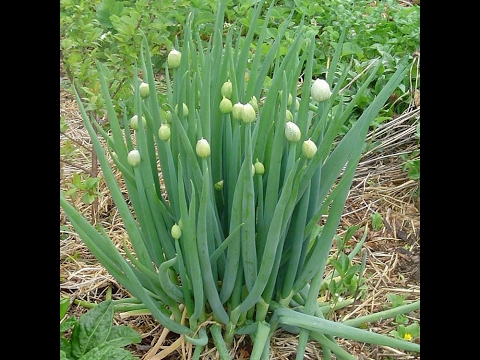

Watch this video on YouTube
Planting onions in open ground
What time to plant
It is recommended to plant onion seedlings in open soil in mid-June after the threat of return frosts has passed and the soil has warmed up well. By this time, the seedlings should be about 60 days old, they should have a developed root system, 3 or 4 true leaf plates, while the thickness of the stem at the base should be from 0.3 to 0.4 cm.
Suitable soil
The area that is suitable for growing a trampoline can be either sunny or shaded. The choice of soil should be approached responsibly, it should be moist, nutritious, slightly acidic or neutral. Loam or sandy loam is best suited for it. In nature, such an onion prefers to grow in low-lying wet places, but in the garden it is not recommended for it to choose areas where water stagnates in spring or during rains. If it is planted on sandy or peat soil, then it will quickly go into the arrow. To deoxidize the soil, 500 ml of wood ash should be added to it per 1 square meter of the plot, and this should be done no later than 6 months before the planting of the trampoline.
You should carefully prepare the site for planting seedlings, because this perennial can be grown on the same site for 4 to 5 years. When about 15 days remain before planting the seedlings, 15–20 grams of potassium chloride, 25–30 grams of ammonium nitrate, 5 kilograms of humus or compost and 30–40 grams of superphosphate per 1 square meter of the site are introduced into the soil for digging, then its surface leveled. Then you can start planting seedlings.
The best predecessors of such a plant are peas, cabbage, green manure, beans and tomatoes. Garlic, cucumbers, onions, and carrots are among the worst predecessors of the batun.
Landing rules
Seedlings of a trampoline are planted in open soil according to the same rules according to which seedlings of other types of onions are planted. In the prepared area, it is necessary to make pits, the distance between which should be about 10-12 centimeters with a row spacing of at least 20 centimeters. If the seedlings were grown by the bouquet method, then they are all planted in the holes together, but they should be placed more spaciously.
Winter landing
Sowing seeds in open soil can be carried out three times during the season, namely in April, June – July and October – November. Thanks to sowing before winter, greens will be obtained very early next season. The preparation of the site for podzimny sowing should be done in the summer. Sowing seeds is carried out after stable cold weather is established, while the air temperature should drop to 3-4 degrees. Seeds are sown very densely, burying 20 mm into heavy soil, and 30 mm into light soil. The row spacing must be at least 20 centimeters. When sowing is completed, the surface of the site is covered with a layer of peat. In order to see the onion seedlings as soon as possible in spring, it is recommended to cover the surface of the site with a polyethylene film. The first seedlings should appear immediately after the snow cover melts. When they are a little older, they will need thinning.
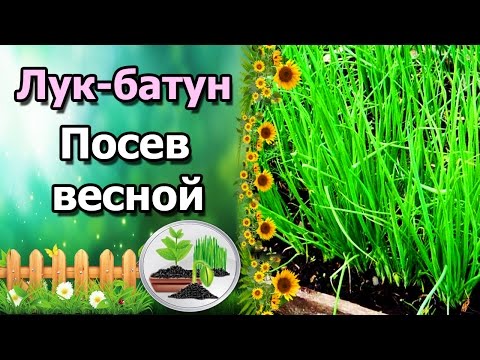

Watch this video on YouTube
Onions on the windowsill
In winter, on your window, you can, if desired, grow fresh greens of a batun. To do this, in the autumn, it is necessary to remove from the ground several bushes of onion-batuna of two or three years of age, while they must be taken together with a lump of earth. Then they are planted in containers or in pots filled with any soil mixture, as long as it is fertile. Then they are placed in a warm place (18 to 22 degrees) and kept in high humidity (about 80 percent). After just 20 days, the first greens will already appear.
You can also grow greens from seeds or from small seedlings. However, it is much faster and easier to get greens from bulbs. If you decide to grow a batun from seed, then you need to be prepared for the fact that the first greens can be cut no earlier than 6 weeks after sowing. The greens grown from the seedlings can be cut after only 15–20 days, but the disadvantage of this method is that the lifespan of the bulbs is no more than 8 weeks. But the bushes that have grown from seeds will regularly produce greens for 2 years, but they will need to be systematically fed 1 or 2 times every four weeks; for this, the soil mixture in a container is watered with a nutrient solution consisting of a liter of water and ½ a cap of Growth.
The seeds need pre-sowing preparation, for this they are poured overnight with clean water, after which they are placed in a solution of sodium permanganate of pink color for 8 hours.A good drainage layer is made at the bottom of the container, then it is filled with a fertile soil mixture consisting of coconut fiber and biohumus (2 :1). The seeds are buried in the substrate by 20-30 mm. Then the crops from above must be covered with glass (film) and they are transferred to a warm place (from 18 to 25 degrees). Immediately after the appearance of the first seedlings, the shelter must be removed, and the container must be rearranged to a cooler place (from 12 to 18 degrees). Seedlings are extremely slow growing, so the first greens can be cut after about 8 weeks. In order for the bushes to grow and develop within normal limits, they most likely need additional lighting with artificial light, while daylight hours are increased by about 3-4 hours.
Only small bulbs are suitable for forcing. Boxes or pots are taken and a layer of fertile soil mixture about 15 centimeters thick is poured into them. Then bulbs are planted close to it. Fill them on top with the same dredge. Then the plantings are watered and transferred to a well-lit place, the recommended air temperature is from 12 to 18 degrees.
Onion care
It is very easy to grow onion on your site. To do this, it must be timely watered, weeded, fed, loosened the soil surface around the bushes, and, if necessary, protected from harmful insects and diseases. The first time it is necessary to loosen the soil surface in the garden bed as soon as the planted seedlings take root. During the first season, it will be necessary to carry out at least 5 or 6 loosening, and ideally it is necessary to loosen the surface of the site after each watering or the last rain. When loosening, you must pull out all the weeds. In order to significantly reduce the number of weeding, loosening and watering, the surface of the garden bed should be covered with a layer of peat. The first cut can be done after the feathers reach 10-15 centimeters in height.
Watering
This culture is moisture-loving, so it must be watered systematically. During watering, the soil should be saturated to a depth of about 20 centimeters. If it rains regularly in the summer, then it is necessary to water the garden a couple of times every 7 days on average. And in dry season, watering should be done every couple of days. Water should be used always warm, while it is poured under the root.
Fertilizer
When 7 days have passed after planting seedlings in open soil, the poor soil should be fertilized with a solution of bird droppings (1:15) or mullein (1:10). If the soil on the site is saturated with nutrients, then its surface, as well as the plants themselves, should be powdered with wood ash. A solution of bird droppings for feeding can be used only once, the fact is that such a plant has the ability to accumulate nitrates, in this regard, only wood ash is used for its further feeding, it will not only saturate the earth with nutrients, but also protect the bushes from harmful insects and diseases.
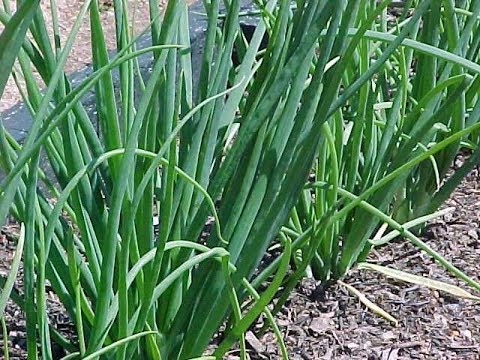

Watch this video on YouTube
Diseases and pests
If you strictly adhere to the agrotechnical rules of this culture, then the plant may not get sick at all, and pests will not disturb it. However, troubles can arise with the baton. Moths, onion weevils and flies can harm this culture.
The onion moth gnaws out the leaf plates from the inside, while only a thin skin remains of them. As soon as such a harmful insect is found, the bushes should be sprayed with an insecticidal contact agent, for example, Fufanon or Karbofos. However, greens should not be cut from the treated plants for some time.
The onion weevil, which is a beetle reaching from 0.2 to 0.27 cm in length, can also harm the foliage of onions; it makes punctures on its surface through which it sucks out the vegetable juice. Its larvae in the foliage gnaw out the passages, which is why it turns yellow and dies off.
The onion fly is similar in appearance to a simple house fly, but it can be very troublesome. The larvae of such a pest gnaw out in the onion cavity.
Such a culture can sometimes suffer from downy mildew (downy mildew). In the affected bush, a violet-gray bloom forms on the surface of the foliage, after which it dies off. Best of all, in the fight against this fungal disease, spraying the bushes with a solution of copper sulfate or the Hom preparation helps; 2 or 3 treatments will be needed with an interval of 1.5 weeks. However, this method of dealing with the disease is not safe for humans.
Onion processing
To protect such a plant from fungal disease and harmful insects, it is necessary to strictly follow the rules of agricultural technology of such a culture, provide it with proper care, and also timely loosen the soil surface near the bushes and pull out all weeds. If you regularly inspect the baton, then the defeat of the disease or pest can be noticed at an early stage, in this case, folk remedies can be used for its treatment, which are non-toxic in comparison with insecticidal and fungicidal preparations. The following folk remedies are most popular with gardeners:
- To protect the bushes from moths, their foliage must be sprayed with a strong solution of mustard powder.
- In order to prevent the appearance of pests in May or June, plants in the open field are given a cold shower.
- The batun is protected from onion flies by treatment with a saline solution (1 tbsp per 10 liters of water), which is carried out twice or three times during the season.
- Spraying the foliage of bushes from the beginning of the spring period with infusion of tomatoes, onions, potato tops or garlic peels will be a prophylaxis against diseases and harmful insects.
Before proceeding with the processing, it is necessary to cut off all the affected leaf plates and dig up all the diseased bushes.
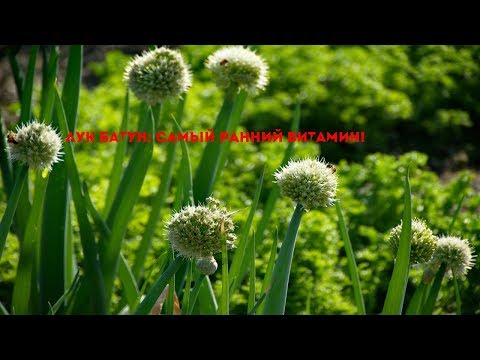

Watch this video on YouTube
Harvesting and storage of onions
Batun onions are cultivated only to obtain greens. It does not form a true bulb in the soil; instead, a thickening, called a false bulb, forms. It can be grown on the same plot for about 10 years, but only the first 3 or 4 years differ with the highest productivity. The fact is that over time, the bushes become overgrown with a large number of daughter plants, and this has an extremely negative effect on the quality of the crop.
During the first season, the bushes actively grow a root system capable of going into the soil to a depth of about 0.3 m. Cutting of greenery begins in the second half of the summer period and continues to do this until autumn. In subsequent years, pruning of feathers begins from the beginning of the spring period, approximately 30 days after the appearance of green shoots. They stop cutting off the greens 4-6 weeks before the start of severe frosts, in this case the onion organs that are underground will be able to prepare well for wintering. During one season, greens can be cut 2-4 times.After the feathers reach a height of 20-25 centimeters, they can be cut, this must be done at the level of the ground surface, after which the feathers are tied into bundles, which are cooled, wrapped in plastic wrap and stored on a refrigerator shelf. To preserve the bulbs extracted from the soil in autumn, intended for subsequent distillation, they are placed in storage in a place where the temperature does not exceed 1 degree, while the foliage cannot be cut off from them.
Types and varieties of onion-batuna
Onions are cultivated in Moldova, China, Western Europe, Ukraine, Russia, Mongolia, Japan and North America. All varieties of such a plant are divided into 2 subspecies, namely: Russian and Japanese. In Russian varieties, the taste of dark green foliage is sharp, it coarsens rather quickly and reaches a height of 0.3 to 0.4 m.This onion is distinguished by strong branching, therefore it is recommended to grow it in the same place for no more than 4 years ... It can be propagated by seed and dividing the bush. The main advantage of these varieties is their high resistance to frost.
The best varieties of Russian batun include the following:
- May... This is a late ripening variety. The bushes with a pungent taste branch strongly, they weigh 200-340 grams. This plant is very resistant to frost, even in winter with little snow at an air temperature of minus 45 degrees, it does not freeze out. A poorly expressed bulb has an elongated shape, the color of the outer scales is dark brown.
- Gribovsky 21... This variety with a very tasty greenish foliage is distinguished by high yield and late shooting.
- Trinity... Such a frost-resistant medium-ripening variety has delicate green foliage with a semi-sharp taste, on its surface there is a waxy coating of medium intensity.
- Russian winter... A frost-resistant salad variety of medium ripening, highly branching foliage reaches a height of about half a meter and has a slightly pungent taste.
Japanese varieties are represented by medium-sized plants, the taste of delicate foliage is peninsular, while in the upper part it droops. These varieties are also resistant to frost, but they cannot be compared with Russian varieties in this. All Japanese varieties are divided into 4 types: Ro, Senju, Kujo and Kaga. The Ro and Kaga varieties have a lot of similarities in structure and appearance, so their bushes are of medium power, and the foliage is of a semi-sharp taste, they differ from each other only in early maturity. The most popular in Japan are the Senju-type varieties, the powerful foliage has a delicate aroma and mild taste, the height of the false stem varies from 0.6 to 0.75 m. open and closed ground. The following varieties are most popular with gardeners:
- April 12... Such an early variety is resistant to diseases and frost, large tender leaf plates of a semi-sharp taste do not become rough for a long time. The shape of the bulb is elongated. The bushes weigh an average of 0.2-0.3 kg.
- Long Tokyo... A frost-resistant medium-ripening variety is distinguished by its yield. The taste of delicate erect leaf plates is sharp, their height is about 0.6 m, and they are covered with a weak waxy coating.
- Long white cat... The variety is frost-resistant and productive of medium ripening. Delicate erect leaf plates are wide and long, there is a waxy coating on the surface. Their taste is semi-sharp.
- Salad 35... The early semi-sharp flavor is resistant to frost and disease. In the second year of growth, 2 or 3 branches appear on the bush with 5 juicy and delicate leaf plates of a dark green color, they do not coarse for a long time, and reach a height of about half a meter. However, such a variety begins to shoot early, so the harvest period is short.
Gardeners are happy to cultivate other varieties of such a plant, for example:
- Ural family... The technical ripeness of such an early ripening variety occurs only 3.5 weeks after the appearance of the first shoots, the taste of feathers is semi-sharp. The height of the bush is about half a meter, it has a large number of false stems, as well as delicate yellowish-green leaf plates with a waxy coating.
- Tenderness... The medium-ripening salad variety is distinguished by its yield and frost resistance. The height of a powerful, branched and erect rosette is about 0.4 m, it includes delicate leaf plates of green color with a barely discernible waxy bloom.
- Parade... Created by Dutch breeders, this medium-ripening variety forms a rosette of greenish-blue foliage with a slight wax coating on its surface. The length of the leaves is about 0.6 m.
- Well done... An early frost-resistant variety, distinguished by its yield, has erect green foliage with a bluish tint of semi-sharp taste, there is a strong bloom of wax on its surface, and its height is about 0.45 m.
- Performer... The medium-ripening variety has an average yield. Green-blue erect leaf plates are tender and juicy, their length is about half a meter, the taste is weak, and there is a strong bloom of wax on the surface.
- Emerald... This is a hybrid between onions and batun. Such an early salad variety is frost-resistant, and is also not affected by diseases; there is a strong waxy coating on the surface of the dark green, juicy and delicate leaf plates.
- Handsome man... This early variety appeared relatively recently, it is resistant to diseases and frost and is fruitful. Delicate foliage does not coarse for a long time, its taste is pleasant, semi-sharp, and its height is about 0.6 m.
- Baron... The taste of the foliage of such an early variety is weak, and its height is about 0.65 m. A large number of false stems with delicate leaf plates of a dark green color with a waxy bloom are formed on the bush.
- Ladozhsky... The medium-ripening salad variety has a mild, delicate taste. The length of erect sheet plates is about half a meter.
- Red snowdrop... The early variety is fruitful and frost-resistant. The height of the juicy and tender foliage is about 0.3 m.
Properties of onion-batuna
Useful properties of onion batun
Batun onions are just as useful as onions, but they contain a greater amount of vitamin C. The composition of the foliage in large quantities includes nicotinic acid, riboflavin, carotene, thiamine, potassium, magnesium and iron salts, essential oil, which gives the foliage a specific smell and slightly bitter taste. Batun is most valuable in spring, because it is at this time that a person most often suffers from vitamin deficiency, and only 150 grams of greens can replenish ½ part of the daily intake of vitamins A and C, as well as 1/5 of the required amount of calcium and potassium, and these elements contribute to improvement work of the cardiac and vascular system. Carotene, which is part of the batun, helps to maintain the mucous membranes and epidermis in good condition. In China, in medicine, such a plant is used as a remedy that has an analgesic, fortifying, hemostatic, diaphoretic, antihelminthic, antibacterial and tonic effect. Nutritionists recommend that people with metabolic disorders in the body, as well as those suffering from liver diseases, gout, hypertension, kidney stones, atherosclerosis and dysentery, be sure to eat a batun.
Batun tincture is used in the treatment of diseases of the cardiovascular system, gastrointestinal tract and fever. To prepare it, you need to combine alcohol (70%) with finely chopped batun (4: 1). The tincture will be ready after 7 days, you just have to strain it. Take it in 15–20 drops, diluted in 50 ml of water.
The broth helps with quick fatigue. For its preparation 1 tbsp. freshly boiled water is combined with 80 grams of finely chopped onion-batuna, cover the container with a lid and wait 30 minutes. The filtered infusion is drunk in 1 tbsp. 2 times a day after meals.
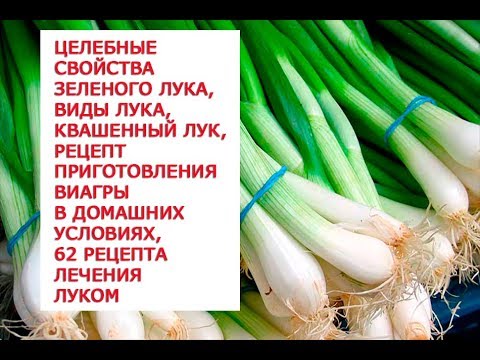

Watch this video on YouTube
Contraindications
Eating too much batun can cause overstimulation. With care, such greens should be eaten with gastritis, pancreatitis, as well as duodenal or stomach ulcers.

